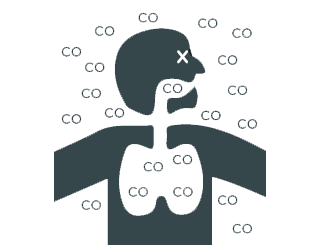This fact sheet is for anyone that hires or sells (supplies) forklifts. Suppliers have a duty to provide customers with relevant health and safety information.
Download:

The exhaust fumes from liquid petroleum gas (LPG), petrol and diesel engine forklifts contain the poisonous gas, carbon monoxide. This gas can rapidly build up in indoor areas and people can quickly become unconscious. Carbon monoxide poisoning can cause permanent brain and heart damage and in serious cases death.
If you hire or sell fuel-powered forklifts for use at work, you have a duty to ensure that your customer has the information they need to choose the right forklift for their workplace.
When does carbon monoxide present a risk?
Carbon monoxide becomes hazardous when forklifts are used indoors or in poorly ventilated areas. If there is insufficient ventilation to remove the exhaust fumes from the workplace they can quickly build up and poison workers.
Some examples of environments where carbon monoxide can be dangerous are:
- buildings with poor ventilation ie no mechanical ventilation to extract harmful gases to the outside
- small buildings
- shipping containers or covered truck trailers
- coolstores, chillers, or freezers
- restricted/confined areas
- a ship's hold, or other similar areas.
What are my duties?
As a supplier you must, so far as is reasonably practicable, ensure that the forklifts you provide for hire or sale will not put the health and safety of workers at risk. This means the forklift should be safe for its intended purpose or other reasonable use for which it was designed or manufactured.
What information do I need to provide to customers?
You should provide your customers with information on the type of work the forklift is designed and manufactured to do. You should also provide any instructions that must be followed to ensure the forklift does not put the health and safety of workers at risk, including advising them of the risks associated with forklifts and carbon monoxide.
Ask your customer if they will use the forklift in areas with poor ventilation. If they will, advise them to hire or purchase an electric forklift instead. Electric forklifts are good to use in any workplace environment as they don’t emit harmful gases.
Hirers/Seller: staff checklist for discussion with customers
- What will you use the forklift for?
- Where will it be used?
- Could the forklift ever be used indoors or in poorly ventilated areas including:
- a warehouse, coolstore, garage, factory or other type of building
- a semi-enclosed area, like a delivery bay
- a shipping container or truck trailer.
If they answer yes to any of the above recommend the use of an electric-powered forklift.
- Tell the customer that if they intend to use a fuel powered forklift indoors or in a poorly ventilated area they must have a safety plan to prevent carbon monoxide poisoning.
- Tell the customer about the importance of keeping the forklift well-maintained to reduce the amount of dangerous gases in the exhaust fumes.
- Provide them with a copy of the fact sheet Forklifts and Carbon Monoxide
You can also advise customers of the risk is to place a sticker or sign in the forklift with a warning of the dangers of carbon monoxide.
For example:
Warning: carbon monoxide poisoning risk
This forklift is fuelled by LPG/diesel/petrol (select one) and emits carbon monoxide when operating. Carbon monoxide is a dangerous gas that can cause headaches, dizziness, unconsciousness and even death. It can quickly build up in areas with limited ventilation. The risk of carbon monoxide exposure increases when forklifts are left to idle when not in active use in or near enclosed areas such as:
- building with poor ventilation
- small building or warehouse
- shipping container or covered truck trailer
- coolstore, chiller or freezer
- restricted/confined area
- ship’s hold, or other similar area
Operate forklifts in well-ventilated areas
Example sticker:

What else can be done to manage the risk?
Make sure that your forklifts are properly tuned; poorly tuned forklifts emit more carbon monoxide. The target emission rate for well-tuned forklifts should be 1% or less. Keeping diesel forklifts well-maintained will also reduce the diesel exhaust emissions which can cause cancer.
Ensure catalytic converters are installed on forklifts. These can reduce carbon monoxide by 70 to 90 percent, but they do not eliminate the danger. They’re not effective until the forklifts’ engine has been running for about 10 minutes so only running them for a short time reduces their effectiveness.
When you supply a PCBU with equipment to use for their work they also have responsibilities to ensure the health and safety of their workers.
Last updated